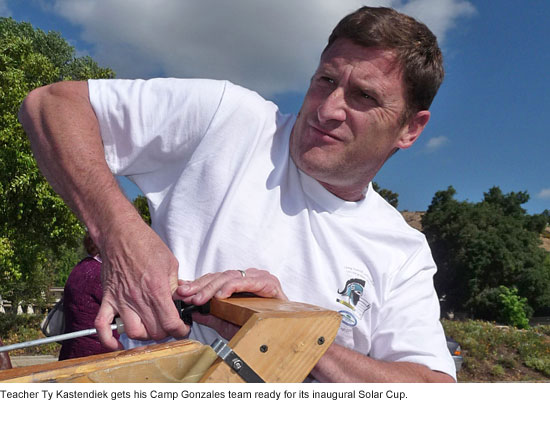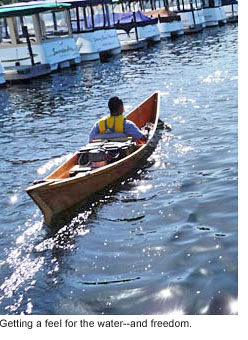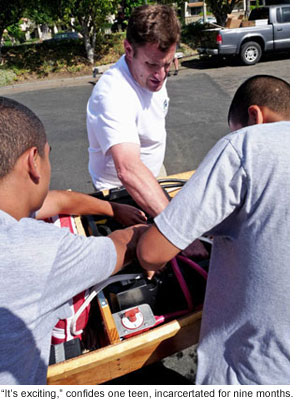Probation teens chart a fresh start
May 13, 2011
 For seven months, Ty Kastendiek’s kids have been readying the Miss Ann for this weekend. Some 20 pairs of young hands have helped build her — hammering, sawing, sanding, varnishing.
For seven months, Ty Kastendiek’s kids have been readying the Miss Ann for this weekend. Some 20 pairs of young hands have helped build her — hammering, sawing, sanding, varnishing.
Fifteen-feet-long, made of wood, she gleams in the sun and all but flies through the water. And to take her out is to know something Kastendiek’s kids appreciate perhaps more than most Southern California boaters: the joy of being free.
Kastendiek—or “Mister Ty”, as his students call him—is a veteran teacher at Camp David Gonzales in the hills above Malibu. Although he has been many things in his life—a purchasing executive, a contractor, an NCAA volleyball player, a Malibu surfer—he has spent the last 18 years teaching history, math and science to incarcerated teens for the Los Angeles County Office of Education. Last summer, he says, he was clicking around on the web when he came across an item about a boat race for high school science students.
“I thought, ‘I like boats’,” he laughed. “I also thought, ‘Yeah, and this would be a long shot.’”
Still, he couldn’t resist taking a closer look at the contest. Sponsored by the Metropolitan Water District, it required participants to build a solar-powered boat, write papers on the science behind it, pull together an environmentally-oriented public service ad and finally race the boat at a grand finale.
It would be tough, Kastendiek realized. Past winners tended to come from affluent suburban school districts, not juvenile lockup. But now, against all odds, he and a team of Gonzales students have cleared every hurdle and then some.
On Saturday and Sunday, they will compete against some 800 students from 40 Southern California high schools in the 9th annual Solar Cup at Lake Skinner in Temecula Valley.
“We’re rookies,” Kastendiek admits, “but I think we’ll make a respectable showing.”
“It’s exciting,” confides one of the teenagers on the team, a soft-spoken 18-year-old from Newhall named Richard who joined the project two months ago, toward the end of a 9-month stint at Gonzales.
 “I’ve never been on a boat like this before,” he said, smiling broadly during a test run this week in Westlake. “I thought I was just going to do my time and go home.”
“I’ve never been on a boat like this before,” he said, smiling broadly during a test run this week in Westlake. “I thought I was just going to do my time and go home.”
Solar Cup coordinator Julie Miller says the contest started as part of the outreach when the MWD was opening the Diamond Valley Lake reservoir in Hemet for recreation. The contest—part regatta, part science project—permits rookie teams to spend up to $4000 on their boats; more veteran teams are limited to $2,500 since, after the first year, they have most of the required parts.
Though only eight boats entered that first year, the Solar Cup is now the largest race of its kind in the nation. Miller says she frequently hears from former contestants. A member of one of the 2007 teams recently wrote to credit the Solar Cup with her decision to become an engineer, says Miller. Two more students who entered as part of a 2008 continuation school team e-mailed to say that the project had inspired them to go on, respectively, to the military and community college.
But this year’s race is the first to feature a team of incarcerated students, and there were some initial hurdles. For one thing, Kastendiek needed a water agency to sponsor the cost of boat building. At the MWD’s suggestion, he called the Las Virgenes Municipal Water District, which stretches from Woodland Hills to Westlake Village.
He wasn’t optimistic. Rules for rookie teams included attendance at two mandatory boat-building workshops; his team couldn’t travel without at least two sworn probation officers to oversee them. Most teams videotaped their public service announcements; his kids’ faces couldn’t appear on film due to court-ordered confidentiality restrictions.
Other teams could make their boats a yearlong class project, but the kids on his team came and went from Gonzales throughout the school year. The teenagers who built and designed the boat in November would not be the same teenagers racing it in May.
But Kastendiek’s call was music to the ears of the Las Virgenes district board members, says public affairs associate Deborah Low.
“We had tried in the past to engage the other high schools in our service area, both public and private, and had never found anyone who wanted to do it,” Low says.
The district’s one request was that the boat be named for the late Ann Dorgelo, a longtime board member from Agoura Hills who had advocated teaching local school children about water conservation.
The boat building began at the start of the school year, with seven or eight students chosen for their interest, their attitude and for their ability to maintain focus and calm, Kastendiek says.
MWD gives each team a basic kit, but the boats vary widely in their look and engineering. The Gonzales boat had to be almost entirely made of wood because the camp doesn’t have a machine shop or welding equipment. Also the design had to be simple—few of the Gonzales kids had ever even been in a boat, let alone built one.
Blueprints were drawn; calculations made. Kastendiek then won permission to take seven or eight kids (with the appropriate supervision) to the official boat-building workshop in early November.
“We built it in about five and a half hours,” he recalls proudly. “Some of those kids had never sawed wood before.”
The team, however, was every bit the revolving door that Kastendiek had feared.
A couple of the boat-builders got into trouble for fighting or defying other teachers and lost their spots. Others were so calmed by the project that they were sent home early for good behavior.
 Kastendiek says he tries not to know too much about his students’ back-stories, the better to give them a fresh start. But working with them day in and day out, it was hard to stay at arm’s length from their struggles. One kid who had thrown his heart and soul into the boat lifted his shirt one day to show Kastendiek the scars from five bullet wounds on his torso. “He told me he was glad he’d been locked up,” the teacher remembers, “because if he hadn’t he’d be dead by now.”
Kastendiek says he tries not to know too much about his students’ back-stories, the better to give them a fresh start. But working with them day in and day out, it was hard to stay at arm’s length from their struggles. One kid who had thrown his heart and soul into the boat lifted his shirt one day to show Kastendiek the scars from five bullet wounds on his torso. “He told me he was glad he’d been locked up,” the teacher remembers, “because if he hadn’t he’d be dead by now.”
By the New Year, the first crew of boat-builders was nearly gone from Camp Gonzales. Again, Kastendiek reached out. Several artistic kids came on to do an interactive print brochure that the group settled on as their public service announcement. (“I told them, “Let’s play to our strength—we have some of the best taggers in L.A. County’,” jokes the teacher.)
The laminated, flexagon-style brochure ended up winning a top prize in the rookie category of the public service part of the contest.
More fresh troops completed the boat’s construction. “Some of these kids were almost borderline hyperactive, and you’d put sandpaper in their hands and after a while, you could see their shoulders drop and all of a sudden, a joy there,” Kastendiek remembers. Still other students discovered a sudden affinity for math in the course of building the boat’s solar-powered engine.
Finally, this week, the boat was ready to hit the water.
“Take a deep breath. Take your time,” Kastendiek urged three team members this week at the Westlake Lake test run as reporters, water district board members, probation officers and assorted dignitaries bustled around them. Someone dropped a metal wrench on the battery. A spark flew. “Don’t worry,” Kastendiek repeated. “Try again.”
Down the shore, a competing team from nearby Oak Park High School unloaded their boat, painted a cheery yellow. Kastendiek’s kids watched from a distance in their orange camp-issued shorts and gray t-shirts as the suburban team confided that they were short-staffed because the AP Physics exams were being held that day.
But on the water, the Miss Ann seemed equal to almost any challenge. Christian, an 18-year-old from Long Beach, and Marco, a 16-year-old from Pomona, laughed out loud as she gathered speed.
“It was thrilling! It was so smooth, and the rudder was so simple,” their teammate Richard marveled as he finished his turn as skipper. None had ever steered a boat before that afternoon, said Kastendiek, who was smiling, too, as they loaded the Miss Ann back onto her small trailer.
“I hope we can make a loud statement that these kids have potential,” he says. “And I hope we can come back again next year.”
Posted 5/11/11












 405 bridge work causes a stink
405 bridge work causes a stink
